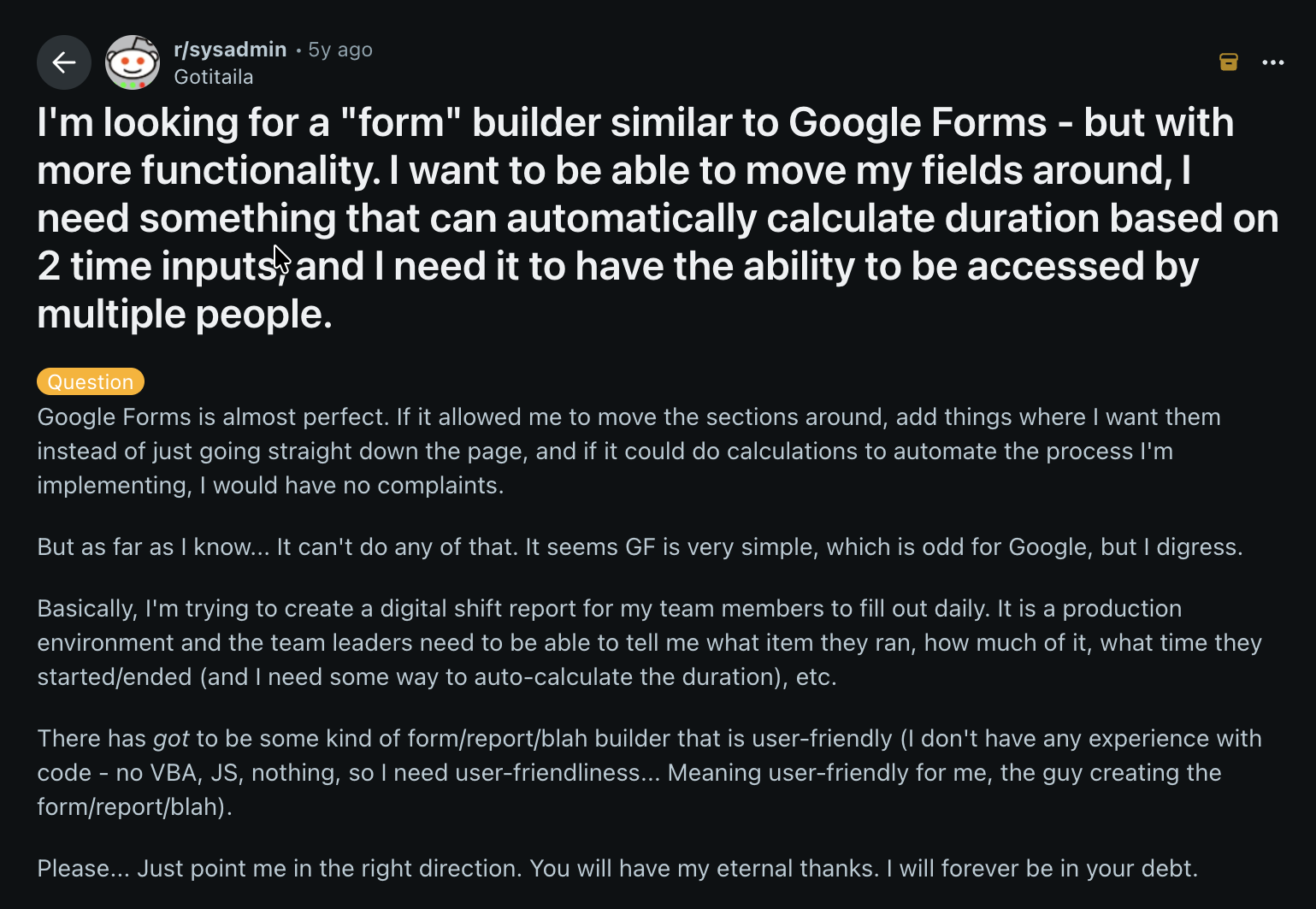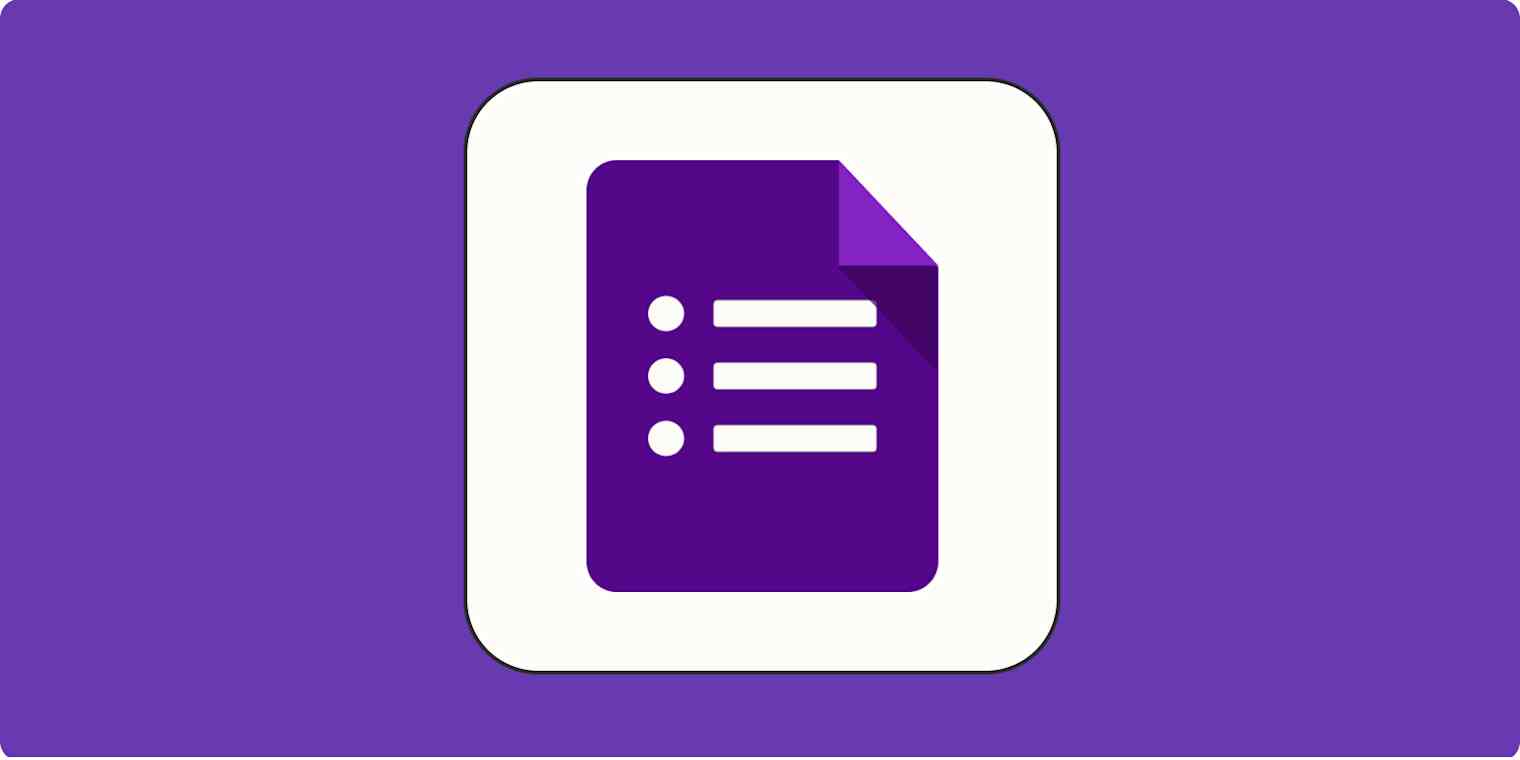
"I'm looking for a 'form' builder similar to Google Forms - but with more functionality. I want to be able to move my fields around, I need something that can automatically calculate duration based on 2 time inputs, and I need it to have the ability to be accessed by multiple people."
This frustration from a Reddit user perfectly captures what many businesses face today. Google Forms, while popular and free, simply wasn't designed for complex business operations that require automatic calculations, flexible field arrangement, and collaborative data collection. When you need forms that can calculate time duration, handle multiple users, or perform arithmetic operations in real-time, Google Forms falls significantly short.

The solution lies in advanced form builders that offer calculation capabilities, multi-user access, and flexible design options. These platforms transform simple data collection into powerful business automation tools, eliminating the need to switch between Google Forms and Excel for calculations. If you're ready to build sophisticated forms beyond Google Forms limitations, you can start building with a no-code platform today.
Google Forms dominates the market with its simplicity and free access, but this simplicity becomes a limitation for businesses requiring advanced functionality. The platform lacks essential features that modern businesses need for efficient operations.
Limited Calculation Capabilities: Google Forms cannot perform automatic calculations within the form itself. Users must export data to Google Sheets and create separate formulas to calculate duration, totals, or perform any arithmetic operations. This manual process is time-consuming and prone to errors. Advanced form builders eliminate this limitation by providing automatic calculations directly within forms.
Restricted Field Flexibility: The drag-and-drop functionality in Google Forms is minimal. Users cannot easily rearrange fields or create complex layouts that match their specific workflow requirements. Multi-column layouts and conditional field arrangements are either impossible or extremely limited. Professional platforms offer extensive form building capabilities with flexible field arrangements.
Multi-User Access Challenges: While Google Forms allows form sharing, it doesn't provide robust multi-user collaboration features for form building and data management. Multiple team members cannot easily access, edit, and manage form responses with proper role-based permissions. Enterprise solutions include comprehensive access control systems.
No Real-Time Calculations: Time duration calculations, order totals, and dynamic pricing cannot be displayed to users as they fill out the form. This lack of immediate feedback reduces user experience and requires additional manual work. Modern form builders support workflow automation for seamless data processing.
Modern form builders address these limitations by offering powerful calculation engines that work in real-time. Time duration calculations become automatic when users input start and end times, eliminating manual computation errors.
Real-Time Duration Calculations: Advanced form platforms can automatically calculate the difference between two time inputs and display the result immediately. Whether calculating work hours, meeting duration, or project timeframes, these calculations happen instantly as users input data. This eliminates the need for manual time tracking and reduces calculation errors.
Complex Formula Support: Beyond simple duration calculations, advanced form builders support complex mathematical operations similar to Excel formulas. Users can create calculations involving multiple fields, conditional logic, and various data types. These platforms often include AI-powered features for enhanced automation.
Dynamic Field Updates: When calculation fields are updated, related fields can automatically refresh, creating a dynamic form experience that responds to user inputs in real-time. This includes features like signature capture for approval workflows.
Multi-Column Layouts: Professional form builders offer flexible layouts where fields can be arranged in multiple columns, sections, and logical groupings that match business processes. Advanced platforms also support attached files and media uploads for comprehensive data collection.
Employee Daily Workflow:
When employees start their workday, they open the time tracking app on their mobile device or computer. The interface presents a clean, organized form that guides them through their daily time entry process.
First, they enter their basic information - name, email, and department selection from a dropdown menu. The system can auto-populate some fields based on their user profile, reducing manual entry time.
Next, they navigate to the time tracking section where they select their work date using an intuitive date picker. The app automatically suggests today's date, but employees can select different dates for retroactive entries if needed.
For time entry, employees use easy-to-navigate time picker fields to log their start time. The interface shows a 12-hour format with AM/PM selection, making it user-friendly for all team members. When they take breaks, they can log break duration, with the system defaulting to standard 30-minute lunch breaks.
At the end of their workday, employees input their end time using the same intuitive time picker. Immediately after entering the end time, the app automatically calculates and displays their total work hours, subtracting any break time. If they've worked over 8 hours, the system automatically calculates overtime hours and highlights this information.
Project Management Integration:
For project-based work, employees select relevant project names from a dropdown menu that pulls from the company's project database. They can add brief task descriptions and specify whether their time is billable. The system automatically calculates daily earnings based on their hourly rate and total work hours.
Manager Approval Process:
Once employees complete their time entries, the submissions automatically route to their designated managers for approval. Managers receive notifications about pending time entries requiring review. They can access a dedicated manager dashboard showing all team submissions, with the ability to approve, reject, or request modifications.
During the approval process, managers can view detailed breakdowns of work hours, overtime calculations, and project allocations. They add their digital signature to approve entries, creating an audit trail for payroll processing. The system supports automated reports generation for streamlined reporting.
Setting Up the Basic Structure
Begin by creating a new form and establishing the main sections. Start with employee information fields including name, email, and department selection. These foundational fields ensure proper data organization and user identification. Modern platforms provide extensive app-building capabilities for creating professional applications.
Add a dedicated time tracking section that will contain all calculation-related fields. This logical grouping makes the form easier to navigate and understand for users. Consider implementing bulk data upload features for importing existing employee data.
Configuring Time Input Fields
Create two time picker fields - one for start time and another for end time. Configure these fields to use 12-hour format for user convenience, though 24-hour format can be used for businesses requiring military time notation. Advanced platforms offer date and time blocks with flexible configuration options.
Set both time fields as required to ensure calculations can be performed accurately. Add validation rules to prevent end times that occur before start times. This prevents data entry errors and ensures calculation accuracy.
Implementing Duration Calculations
Add a calculation field that automatically computes the difference between start and end times. The formula should account for break periods by subtracting break duration from total time. Professional form builders provide formula blocks for complex calculations.
Configure the calculation to display results in hours and minutes format for easy reading. Set up conditional logic to handle overnight shifts if your business operates across midnight. Advanced systems also support location tracking for remote workforce management.
Creating Multi-User Access Controls
Establish user roles and permissions that allow employees to input their time data while enabling managers to review and approve submissions. Configure the form so that employees can only edit their own entries while supervisors can access all team submissions. Implement user management features for proper access control.
Set up notification workflows that alert managers when time entries require approval. This automated process ensures timely review without manual tracking. Consider integrating email notifications for seamless communication.
Adding Advanced Features
Include overtime calculation fields that automatically determine hours worked beyond standard schedules. Create dynamic pricing calculations that multiply hours by hourly rates to show earning projections. Advanced platforms offer bar graph analytics for visual data representation.
Implement signature capture for both employees and managers to ensure accountability and approval documentation. These digital signatures provide audit trails for time tracking records. Integration with payment gateways can streamline payroll processing for service-based businesses.
Advanced form builders excel in supporting multiple users accessing and managing the same form data. Unlike Google Forms' basic sharing capabilities, these platforms offer sophisticated user management systems.
Role-Based Access Control: Different users can have varying levels of access - from basic form filling to complete administrative control. Employees might only access their own data while managers can view team-wide submissions. Professional platforms include comprehensive permission systems for secure collaboration.
Real-Time Collaboration: Multiple users can work on form responses simultaneously without conflicts. Changes are synchronized across all users, ensuring everyone works with the most current information. This includes live tracking capabilities for field operations.
Approval Workflows: Built-in approval processes allow submissions to move through multiple review stages automatically. Managers receive notifications when their approval is required, streamlining the review process. Advanced systems support conditional workflows for complex business rules.
Data Security: Multi-user access includes security features that protect sensitive information while allowing necessary collaboration. User activity logs track who accessed what data and when. Enterprise solutions provide data export capabilities for integration with existing systems.
Project Time Tracking: Consulting firms use advanced forms to track project hours across multiple team members. Automatic calculations provide real-time project cost analysis and help maintain budget controls. Integration with QR code scanning enables quick project check-ins at different locations.
Service Appointment Scheduling: Service businesses calculate appointment duration and associated costs automatically. When customers select services, the form calculates total time required and displays pricing immediately. This streamlines the booking process and improves customer experience.
Event Planning and Coordination: Event organizers use time calculation forms to coordinate schedules across multiple vendors and team members. Duration calculations help optimize scheduling and resource allocation. The ability to check current pricing helps businesses choose appropriate plans for their event management needs.
These use cases demonstrate how advanced form builders transform simple data collection into comprehensive business process automation. The combination of calculations, multi-user access, and flexible design creates powerful tools that replace multiple software applications.
Advanced form builders with calculation capabilities offer significant advantages over Google Forms for businesses requiring sophisticated data collection and processing. By implementing time calculations, multi-user collaboration, and flexible layouts, organizations can streamline operations and improve accuracy while maintaining user-friendly interfaces.
The investment in advanced form building capabilities pays dividends through reduced manual work, improved data accuracy, and enhanced collaboration capabilities that Google Forms simply cannot provide. Whether you need AI-powered automation, comprehensive analytics, or mobile-responsive design, modern no-code platforms offer the tools necessary to build professional applications that exceed Google Forms limitations. Start building your advanced forms today and experience the difference that purpose-built business applications can make for your organization.

L374, 1st Floor, 5th Main Rd, Sector 6, HSR Layout, Bengaluru, Karnataka 560102, India

3500 S DuPont Hwy, Dover,
Kent 19901, Delaware, USA


3500 S DuPont Hwy, Dover,
Kent 19901, Delaware, USA

L374, 1st Floor, 5th Main Rd, Sector 6, HSR Layout, Bengaluru, Karnataka 560102, India


.jpg)




.png)
